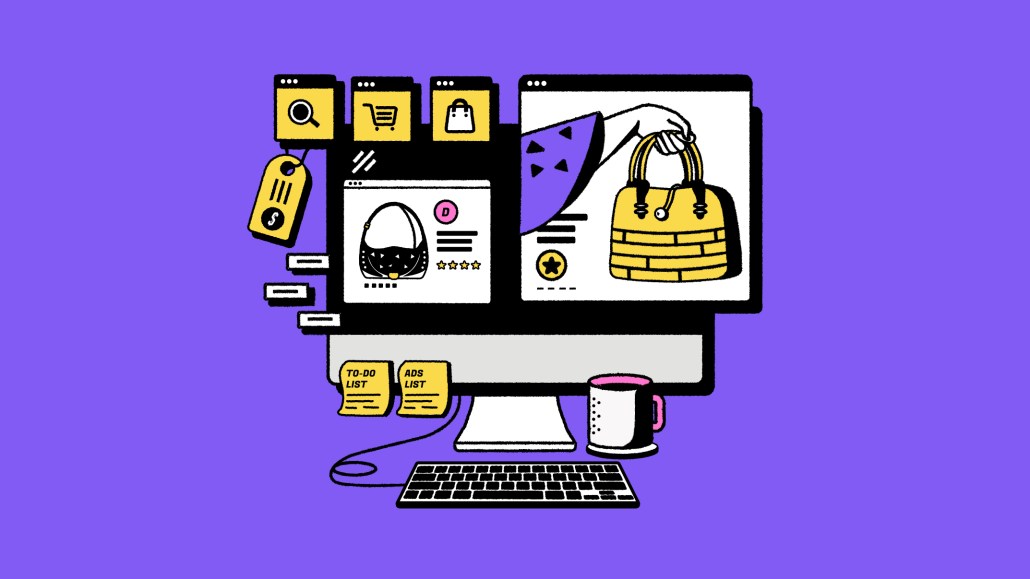Save 50% on a 3-month Digiday+ membership. Ends Dec 12.
Microsoft heralds a new age of AI ‘copilots’ across hardware, software — and advertising

As Microsoft builds new AI tools into every device and software platform, it’s also expanding tests for AI-powered advertising.
At its fall event in New York yesterday, Microsoft unveiled new generative AI features across Windows, Edge, Bing and Microsoft 365. It also debuted two new laptops. Powering all these will be the redesigned Microsoft Copilot, a unified AI assistant to help people navigate across apps, operating systems and devices.
The current AI race is ushering in the “age of copilots,” CEO Satya Nadella said during his opening remarks, adding that it’s “kind of like your PC is now becoming your CP.”
“We believe Copilot will fundamentally transform our relationship with technology,” Nadella said. “I started at Microsoft when our mission was to put a PC in every home and every desk. And today we have a vision for a copilot that can empower every person and every organization on the planet.”
When the next Windows 11 update arrives Sept. 26, it’ll have 150 new features — with many powered by Copilot, which will be available the same day. Microsoft also plans to release Microsoft 365 Copilot on Nov. 1 for enterprise customers.
One of the ways everyday users will access the new features is through an updated Bing Chat, which can now personalize chat results with interest-based answers drawing on past conversations. Users will also get updates including more personalized online shopping and the ability to create images with DALL-E 3 for free. However, some of the more powerful and impactful features for businesses include new tools for Outlook, Excel, OneNote, Word and other programs.
Among the many new Copilots is one created for Microsoft’s advertising platform that will help answer questions, provide content recommendation and enable other features in the coming months. For example, the Copilot will provide advertisers with insights about their campaigns and generate new images for ads used on products and search trends.
Although non-advertising tools took center stage at the event, Microsoft has also created new genAI ad formats inside of Bing Chat. The first new format, dubbed “compare and decide ads,” will let advertisers get involved with how shoppers decide what to buy. The format’s still in Alpha testing, but a closed Beta test is planned for January.
The new AI ad format is based on data showing people are using Bing Chat to research and compare products, said Kya Sainsbury-Carter, corporate vp of Microsoft Advertising. For example, someone shopping for cars might get an ad from an auto brand showing a “very succinct” table with info about various makes and models.
“That makes it super easy to compare across options that are relevant to what the user has said is important to them,” Sainsbury-Carter said. “We think there are some really interesting use cases and that those use cases map very closely to what the user is telling us that they’re interested in.”
Chat ads are already providing a clickthrough-rate that’s nearly double other Bing ads, said Sainsbury-Carter. She noted that Bing Chat is also increasing users’ dwell time and that AI-powered shopping ads are seeing an 11% increase in clickthroughs.
Microsoft is also moving forward its chat API for publishers that it announced in May, starting with Snap and Axel Springer as the first revealed partners. For Snapchat, the chat API will help power ads inside of the social platform’s My AI bot. For Axel Springer, the chat ads integration is starting with “Hey,” a recently announced ChatGPT-powered bot created by the German daily newspaper BILD.
Sainsbury-Carter declined to disclose any revenue sharing details or other info about either partner, but said the focus is on publishers where having a chat option “makes sense.” So far, the AI ad formats for the publisher API are the the same as those already introduced on Bing Chat — including text ads, shopping ads and now the new Compare ads.
Microsoft’s news come the same week as rivals like Google and Amazon announced major updates for their own genAI platforms. On Tuesday, Google announced updates for its Bard chatbot and new integrations for major apps like YouTube, Gmail, Google Docs and Google Maps. A day later, Amazon debuted an updated language model called Alexa LLM to power a range of features for its newly announced suite of smart devices.
The new AI features within Copilot and Bing will help advertisers create user profiles for targeted advertising, noted Patrick Moorhead, CEO and chief analyst at Moor Insights & Strategy. That’s also something other tech giants are also likely to pursue.
“Both Microsoft and Amazon have grand aspirations of increasing their amount of advertising revenue,” Moorhead said. “I think you should follow the data to see the approaches that they will take. Look at the data that Amazon has, and then look at the data that Microsoft has. Both will leverage those into their advertising strategies.”
More in Media

The Washington Post debuts AI-personalized podcasts to hook younger listeners
The Washington Post has used AI to build a pick-your-own-format news podcast, letting listeners choose the topics, hosts and duration.

Workforce data, smarter AI integration among greatest workplace priorities in the new year
The growing importance of workforce data is just one of the prognostications people managers are making looking to the year ahead.

WTF is AI citation tracking?
Publishers are tracking AI citations to understand visibility, attribution gaps and referral traffic in these tools and platforms.








